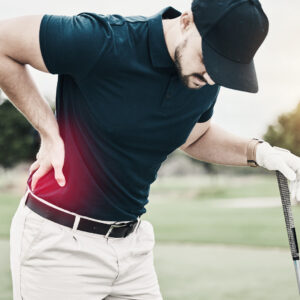Common Golf Injuries and How to Prevent Them
Fairway Fitness: A Physical Therapist’s Guide to Scoring Par Pain-Free

With its reputation for elegance and precision, golf requires a delicate balance of strength, flexibility, and biomechanical finesse. The sport has seen a significant rise in participation over recent years, with millions taking to the greens annually across the US.
Orlin & Cohen’s Dr. Lewis Lupowitz, a fellowship-trained sports physical therapist, explains the most common golf injuries with exercise strategies to help you prevent and recover from them.
Common Golf Injuries: How to Safely Navigate the Hazards
Golf is a sport with a surprisingly high rate of injury. Research shows that anywhere from 25% to 67% of amateur golfers experience injuries, the most common being elbow issues, shoulder strains, and problems with the lumbar spine.
Interestingly, a significant number of injuries occur during the golf swing itself, with close to a quarter happening precisely at the point of ball impact. However, many injuries also occur outside of the swing.
Thankfully, a proper warm-up can reduce your risk of injury and can even enhance your game. By gradually increasing heart rate, blood flow to muscles, and body temperature, a thorough warm-up contributes to better joint flexibility and a wider range of motion during your swing. To top it off, when your body is warmed up, you’re better prepared for the neurological demands of golf, leading to improved coordination and muscle activation.
To help you get started, here are stretches specifically tailored to prevent the three most common golf injuries.
Golfer’s Elbow (Medial Epicondylitis)
A prevalent issue among players of the sport, Golfer’s Elbow is caused by repetitive strain on the wrist and forearm, especially during the swinging motion and club grip. This stress can lead to pain on the inside of the elbow, affecting the tendons connected to the medial epicondyle.
Exercise recommendations
1. Golf club wrist curls
Hold a golf club with both hands, palms facing upwards. Slowly curl your wrists upward, lifting the club towards you. Hold this position for a moment, then slowly lower the club back down, using the club’s weight as resistance. Focus on keeping the movements controlled and engaging the muscles in your forearms.
2. Golf club wrist extensions
Using both hands, grasp a golf club with your palms facing downwards. Extend your wrists upward, lifting the club with controlled movements. Over time, this exercise will strengthen the extensor muscles in the forearms and enhance wrist flexibility.
3. Golf club wrist supination and pronation
Hold a golf club with both hands, your elbows bent at 90 degrees. Rotate your wrists to supinate (turning your palms up), then pronate (turn your palms down). Complete the rotations in a controlled motion, using the club for resistance to improve forearm strength and flexibility.
Shoulder Impingement
The repetitive swinging motion of the sport can really take its toll on your shoulder over time, leading to rotator cuff impingement. To prevent this painful condition, focus on thoracic mobility and strengthening the rotator cuff muscles. Make sure to include exercises that target these areas (like the ones below) to reduce your risk of injury and improve shoulder health.
Exercise recommendations
1. Cross body stretch
To begin, stand tall, holding the club vertically in your left hand. Bring the left arm across your chest. Using your right hand, grip the elbow and gently pull the left arm into your body. Hold for a few seconds and repeat on the opposite side.
2. Golf club around the world
Start by holding a golf club horizontally in front of you. Slowly rotate the club in a circular motion, both clockwise and counterclockwise, keeping your arms extended.
3. Lunge stance Y
Take a lunge stance and hold a golf club diagonally across your body at a 45-degree angle. Lift the club with straight arms to shoulder height, engaging your shoulder muscles in a scaption motion (raising your arms from your sides and slightly forward).
4. Lunge stance rotations
Assume a lunge stance and place a golf club across your upper back. Rotate your torso towards the front knee while using the club for support.
Low Back Pain
Low back pain is a common condition among golfers, often stemming from the complex and powerful movements of their golf swing. To prevent lower back issues, take a comprehensive approach to conditioning your body for the sport. This includes improving hip mobility and core stability, as strengthening these areas not only reduces the risk of injury but also enhances overall golf performance. By focusing on these fundamentals, golfers can safeguard their backs and optimize their game.
Exercise recommendations
1. Hip external rotation stretch
Stand with your feet shoulder-width apart. Cross one ankle over the opposite knee and gently lower yourself into a seated position. You should feel a stretch in your hip and glute area.
2. Romanian deadlift (RDL) rotations
Stand with your feet shoulder-width apart, holding a golf club with both hands. Hinge at the hips to perform a Romanian deadlift (where the body bends at the hips and the knees are not bent) while incorporating a rotation towards one side.
Once you’ve mastered the basic movement, try performing it on one leg at a time for an added challenge.
3. Lunge stance chops
Assume a lunge stance while holding a golf club with both hands. Rotate the club diagonally across your body from the outside of one hip to above the opposite shoulder. Engage your core in a dynamic chop motion to enhance rotational strength and stability.
By proactively incorporating these targeted stretches and strengthening exercises into your routine, you can enhance flexibility, improve muscle stability, and reduce the likelihood of golf injuries.
Whether it’s from swinging the iron or another common athletic injury, some injuries are unavoidable, even with preventative techniques. When they occur, you can trust Orlin & Cohen’s top-ranked orthopedic team, including fellowship-trained sports medicine subspecialists and physical therapists, to bring compassion and the latest techniques to help relieve the pain and get you back into the game.



